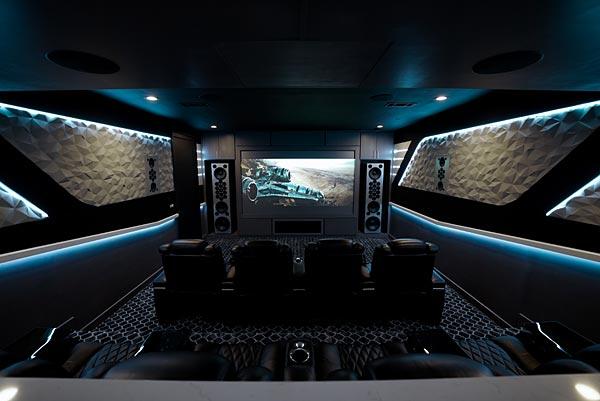Custom Home Entertainment in Covid Times

It's been a strange two years for home entertainment as Covid came and went, came and went, came and... It's been even stranger for home theater, as is made clear in the May 2022 issue of the industry trade publication, CEPro.
In that issue they cover how the past year, in particular, has affected AV installers. The latter do customized home theaters, multipurpose entertainment spaces, and home automation/multi-room systems. Today such companies are often referred to as "Integrators" a somewhat more grandiose title than custom installers. The data presented in CEPro reflect a custom contractor's work; they don't include the possibly far larger do-it-yourself (DIY) space in which most home theater enthusiasts live. But it's nonetheless interesting to look at the custom install business. It has much to say about the overall issues facing the industry.
The impact of Covid on the tech integration business has been challenging to say the least, particularly the resulting supply chain issues. The products in shortest supply have been preamp-processors and AVRs, as you might expect given he microchip shortages we've been hearing about for the past year. Most of the news about the chip shortage has centered on its impact on cars, but microchips are now vital to almost everything tech-related. The product categories least affected have been, not surprisingly, cables and non-powered loudspeakers. But that could change given the current "Covid Zero" policies in China, where most such products originate.
A widely used industry definition for a home theater includes everything from a 42-inch (minimum) TV with a soundbar to a multi-million dollar home movie palace. But the data presented in CEPro are unlikely to be skewed much by a TV with soundbar; buyers in that market are far more likely to DIY.
In no way can we cover here all of the data presented in the CEPro article. We can only offer a taste. You won't find that publication on any newsstand, nor in your public library unless perhaps you live in Silicon Valley. The magazine is normally limited to the trade, but if you're in the business, plan to go into the business, want more information about the business, or just play an integrator on TV, you can check out CEPro online here.
I was puzzled by an observation in the article suggesting that home theater has continued making a strong comeback. I didn't know it had gone anywhere apart from the general economic slowdown in 2020. But the prior years' dip in customized home theater installations was now showing an unexpected, upward bump.
In any case, custom installed multipurpose rooms, in which the home theater is only one of the entertainment options, accounted for an average of six finished jobs per integrator vs. four for dedicated home theaters. But the integrators surveyed claimed that had it not been for the supply chain issues their number of finished home theaters might have doubled.
In other home theater stats (again, per installer), the average number of loudspeakers in each installation was six (5.1 is alive and well; Atmos perhaps not so much!). The number of seats was five (not a lot of Super Bowl parties in that house). Subwoofers were used in 79% of the home theater setups. Flat screen TVs were, surprisingly, more widespread than projectors by a 61% to 39% margin, though I suspect projectors dominate in the pricier, dedicated home theater installs.
Interestingly, 39% of the home theater installations included a soundbar. This doesn't necessarily mean that they used only a soundbar; separate surrounds and a subwoofer or two would also fall into this group. Blu-ray players found their way into only one-third of the installs (sad!), and 60% of the speakers used were in-walls (ditto sad, though not at all surprising).
Basement installations weren't overly popular; they were present in only 20% of custom jobs. That may reflect the fact that few houses today include full basements, and even where available the need to run up and down stairs to refill snacks from the kitchen, or take a pause for the cause, might also account for some of the subterranean reluctance. Adding a kitchen and restroom where none were previously present would also add substantially to the price of a basement home theater.
The cost of these custom installations is likely heavily skewed by wide differences in prices between, say, New York City and Omaha. This variation was not addressed in the stats presented in the article. But the average reported price point was just over $50,000 for a dedicated home theater and $27,500 for a multipurpose room. Interestingly, both were up dramatically from about $28,000 (theater) and $17,000 (entertainment room) in 2020. Inflation, supply chain issues, and lack of manpower were cited as possible reasons for the increases. Lack of manpower drives integrators to use their time and limited help on more profitable and pricier jobs.
Nevertheless, a significant number of home theater installs were lower priced, including 17% in the $10,000 to $25,000 range (14% for multipurpose home entertainment rooms in this price range). And 23% of home theaters (33% multipurpose rooms) were between $5,000 and $10,000.
Most of us still rely on ourselves, significant others, and friends to complete a DIY home theater or multipurpose home entertainment space. It might not look like Radio City Music Hall or the bridge of the starship Enterprise, but there's a certain satisfaction in sweat equity. A good custom installer can do the job, but the tradeoff is cost. Nevertheless, even if you are able to go the custom route it still helps if you know enough about the subject to better communicate your desires to the installer. Oops, sorry — integrator.





























































